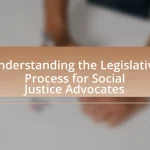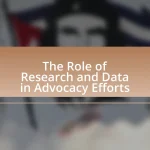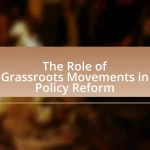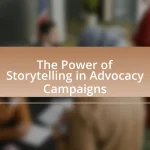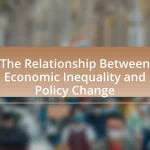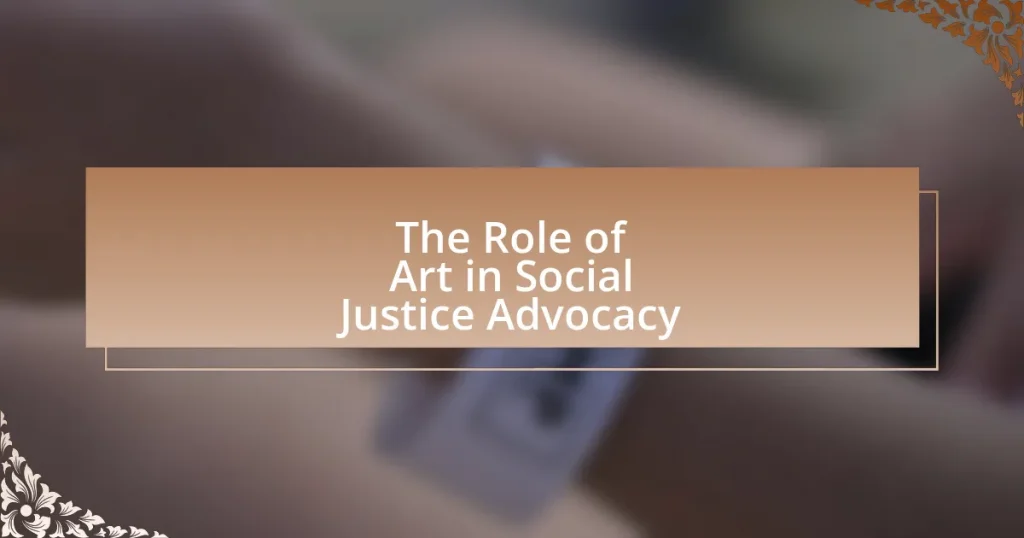The article examines the significant role of art in social justice advocacy, highlighting how various forms of artistic expression—such as visual arts, music, and performance—serve as powerful tools for raising awareness, fostering dialogue, and mobilizing communities around social issues. It discusses historical and contemporary examples, including movements like Black Lives Matter and the Civil Rights Movement, illustrating how artists have effectively communicated messages of resistance and solidarity. The article also explores the psychological impacts of art on audiences, the challenges artists face in advocating for social justice, and the emerging trends in digital media and community engagement that enhance the effectiveness of artistic advocacy.
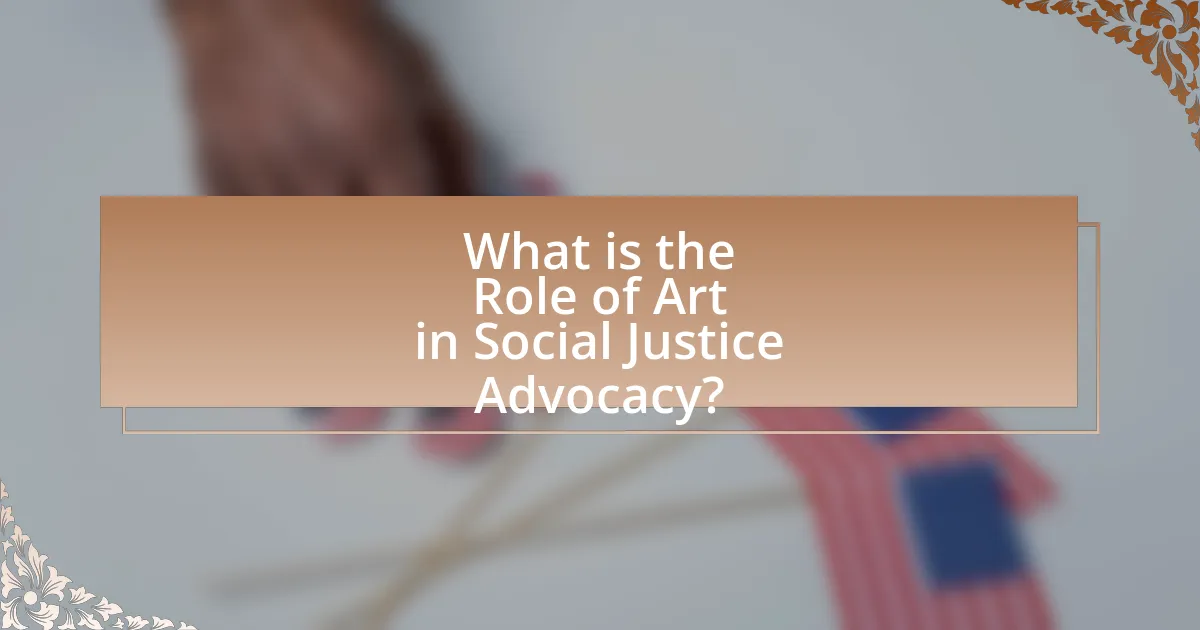
What is the Role of Art in Social Justice Advocacy?
Art plays a crucial role in social justice advocacy by serving as a powerful medium for expression, awareness, and mobilization. Through various forms such as visual arts, music, and performance, artists can highlight social issues, challenge injustices, and inspire collective action. For instance, the use of street art during movements like Black Lives Matter has effectively communicated messages of resistance and solidarity, reaching diverse audiences and fostering dialogue. Historical examples include the works of artists like Diego Rivera, whose murals depicted social struggles, and the Harlem Renaissance, which used art to address racial inequality. These instances demonstrate that art not only reflects societal issues but also actively participates in the advocacy for change.
How does art contribute to social justice movements?
Art contributes to social justice movements by serving as a powerful tool for expression, awareness, and mobilization. Through various forms such as visual art, music, and performance, artists can highlight social issues, evoke emotional responses, and inspire collective action. For instance, the use of murals in urban areas has historically been a means to communicate messages about inequality and resistance, as seen in the works of artists like Diego Rivera, whose murals addressed class struggles in Mexico. Additionally, art can create a sense of community and solidarity among marginalized groups, as demonstrated by the role of protest songs during the Civil Rights Movement in the United States, which united activists and amplified their messages. Thus, art not only reflects societal issues but actively participates in the dialogue and actions surrounding social justice.
What forms of art are most commonly used in social justice advocacy?
Visual art, music, theater, and literature are the most commonly used forms of art in social justice advocacy. Visual art, including murals and installations, serves as a powerful medium to convey messages and raise awareness about social issues, as seen in the works of artists like Banksy. Music, through genres such as hip-hop and folk, often addresses themes of inequality and resistance, exemplified by artists like Kendrick Lamar and Joan Baez. Theater engages audiences in critical dialogues about social justice, with productions like “The Vagina Monologues” highlighting women’s rights. Literature, including poetry and essays, provides a platform for marginalized voices, as demonstrated by authors like Audre Lorde and James Baldwin. These forms of art not only communicate messages but also inspire action and foster community engagement in social justice movements.
How does art communicate messages of social justice?
Art communicates messages of social justice by visually representing societal issues, provoking thought, and inspiring action. Through various mediums such as painting, sculpture, and performance, artists can highlight injustices like racism, inequality, and oppression, making these issues more accessible and relatable to the public. For instance, the mural “The Great Wall of Los Angeles” illustrates the history of marginalized communities in California, effectively raising awareness about social issues. Additionally, art can serve as a form of protest, as seen in the works of artists like Ai Weiwei, whose installations critique government policies and human rights violations. This ability to engage emotions and foster dialogue makes art a powerful tool for social justice advocacy.
Why is art an effective tool for raising awareness?
Art is an effective tool for raising awareness because it engages emotions and provokes thought, making complex social issues more accessible. Through visual imagery, music, and performance, art can communicate messages that resonate on a personal level, often transcending language barriers. For instance, the AIDS Memorial Quilt, which visually represents the impact of the AIDS crisis, has been instrumental in raising awareness and fostering empathy towards those affected. Studies show that emotional engagement through art can lead to increased understanding and action regarding social justice issues, as evidenced by the success of campaigns like “Black Lives Matter,” which utilize art to convey powerful messages about racial inequality.
What psychological impacts does art have on audiences regarding social issues?
Art significantly influences audiences’ psychological responses to social issues by evoking empathy, raising awareness, and prompting critical reflection. Through visual imagery, storytelling, and performance, art can create emotional connections that foster understanding of complex social problems. For instance, studies have shown that exposure to art addressing social justice themes can lead to increased empathy and a greater willingness to engage in advocacy efforts. Research published in the journal “Psychology of Aesthetics, Creativity, and the Arts” indicates that art can enhance emotional engagement, which in turn motivates individuals to take action on social issues. This demonstrates that art serves as a powerful tool for shaping public perception and inspiring social change.
How does art foster empathy and understanding in social justice contexts?
Art fosters empathy and understanding in social justice contexts by providing a visceral representation of marginalized experiences, allowing audiences to connect emotionally with issues they may not personally encounter. For instance, visual art, literature, and performance can depict the struggles of oppressed communities, making their narratives accessible and relatable. Research by the National Endowment for the Arts indicates that engagement with art can enhance emotional intelligence and foster social cohesion, as it encourages individuals to reflect on their own beliefs and biases. Furthermore, art can serve as a catalyst for dialogue, prompting discussions around social justice issues and inspiring collective action, as seen in movements like the Black Lives Matter campaign, where art has been pivotal in conveying messages of resistance and solidarity.
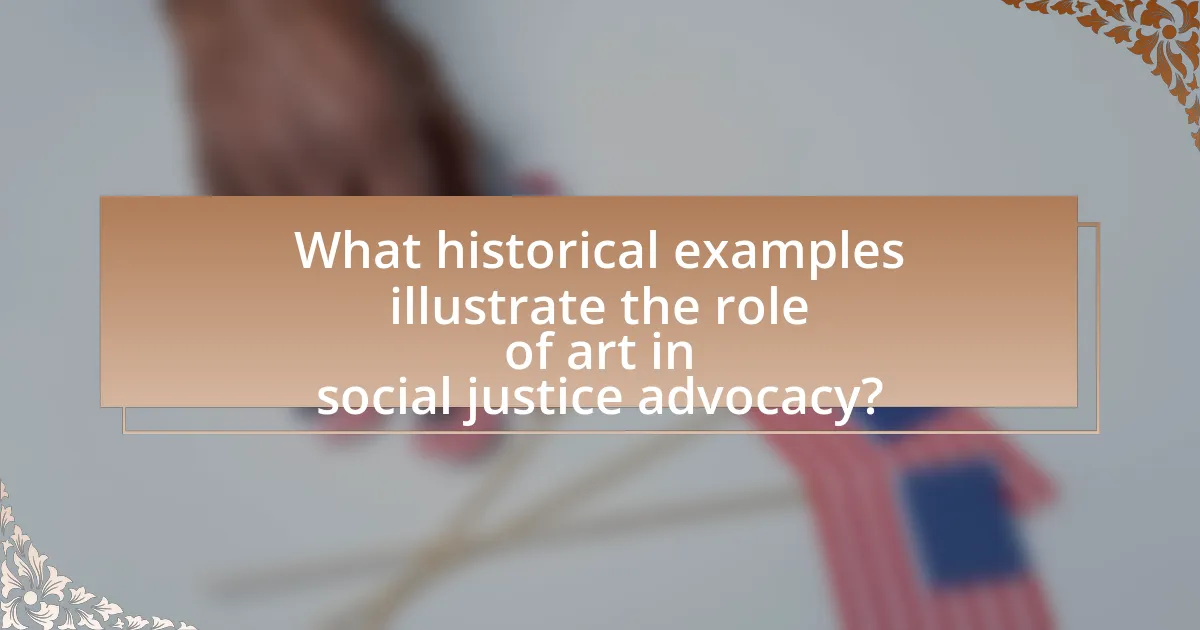
What historical examples illustrate the role of art in social justice advocacy?
Art has historically played a crucial role in social justice advocacy, exemplified by movements such as the Harlem Renaissance, which used literature, music, and visual arts to challenge racial discrimination and promote African American culture. During the 1960s, artists like Diego Rivera and the Mexican muralists created works that addressed social inequalities and labor rights, influencing public perception and policy. Additionally, the AIDS activism of the 1980s, particularly through the work of artists in the ACT UP movement, utilized visual art and performance to raise awareness and demand action against the government’s inaction on the epidemic. These examples demonstrate how art has been a powerful tool for social change, mobilizing communities and shaping discourse around justice issues.
How have artists historically contributed to social justice causes?
Artists have historically contributed to social justice causes by using their creative platforms to raise awareness, inspire change, and mobilize communities. For instance, during the Civil Rights Movement in the United States, musicians like Bob Dylan and Nina Simone wrote songs that highlighted racial injustices and called for equality, such as Dylan’s “The Times They Are a-Changin'” and Simone’s “Mississippi Goddam.” Additionally, visual artists like Diego Rivera and Frida Kahlo used their artwork to critique social inequalities and advocate for the rights of marginalized groups. These contributions have been pivotal in shaping public discourse and galvanizing support for various social justice movements throughout history.
What notable movements have utilized art for advocacy?
Notable movements that have utilized art for advocacy include the Civil Rights Movement, the Feminist Movement, and the LGBTQ+ Rights Movement. The Civil Rights Movement employed visual art, music, and literature to highlight racial injustices and promote equality, exemplified by works like the song “We Shall Overcome.” The Feminist Movement used art to challenge gender norms and advocate for women’s rights, as seen in the Guerrilla Girls’ provocative posters. The LGBTQ+ Rights Movement has leveraged art to express identity and fight for acceptance, with events like Pride parades showcasing vibrant visual art and performances. These movements demonstrate how art serves as a powerful tool for social change and advocacy.
How did specific artworks influence public perception of social issues?
Specific artworks have significantly influenced public perception of social issues by raising awareness and prompting dialogue. For instance, Pablo Picasso’s “Guernica” powerfully depicted the horrors of war and the suffering it inflicts on civilians, leading to increased anti-war sentiment and activism during the Spanish Civil War. Similarly, the “I AM a Man” photograph from the 1968 Memphis sanitation workers’ strike became an iconic representation of the civil rights movement, galvanizing public support for labor rights and racial equality. These artworks not only captured the emotional essence of their respective issues but also served as catalysts for social change, demonstrating art’s ability to shape public consciousness and inspire action.
What lessons can be learned from past art-driven social justice campaigns?
Art-driven social justice campaigns demonstrate the power of creativity in mobilizing communities and raising awareness about social issues. These campaigns often highlight the importance of emotional resonance, as art can evoke empathy and provoke thought, making complex issues more accessible. For instance, the AIDS Memorial Quilt, which began in 1987, effectively used visual art to humanize the AIDS crisis, leading to increased awareness and funding for research. Additionally, campaigns like the “I AM a Man” poster during the Civil Rights Movement illustrated how art can serve as a rallying cry, unifying individuals around a common cause. These examples show that art not only communicates messages but also fosters community engagement and activism, proving that visual storytelling can be a catalyst for social change.
What strategies were most effective in these campaigns?
The most effective strategies in social justice advocacy campaigns utilizing art include community engagement, storytelling, and visual impact. Community engagement fosters collaboration and participation, allowing artists to connect with the audience on a personal level, which enhances the campaign’s reach and resonance. Storytelling through art conveys complex social issues in relatable ways, making the message more accessible and emotionally impactful. Visual impact, achieved through striking imagery or performance, captures attention and provokes thought, often leading to increased awareness and action. For instance, the “Art for Justice Fund” effectively used these strategies to raise awareness about mass incarceration, demonstrating that art can mobilize communities and drive social change.
How did community engagement play a role in these artistic efforts?
Community engagement was crucial in these artistic efforts as it fostered collaboration between artists and local populations, ensuring that the art produced resonated with the community’s experiences and needs. This collaboration often led to the creation of works that addressed specific social justice issues relevant to the community, such as inequality or discrimination. For instance, projects like community murals or participatory theater not only involved local voices but also empowered residents to express their narratives, thereby enhancing the impact of the artistic efforts on social change. Research indicates that art initiatives that actively involve community members are more effective in raising awareness and driving action on social justice issues, as they reflect the authentic concerns and aspirations of the community.
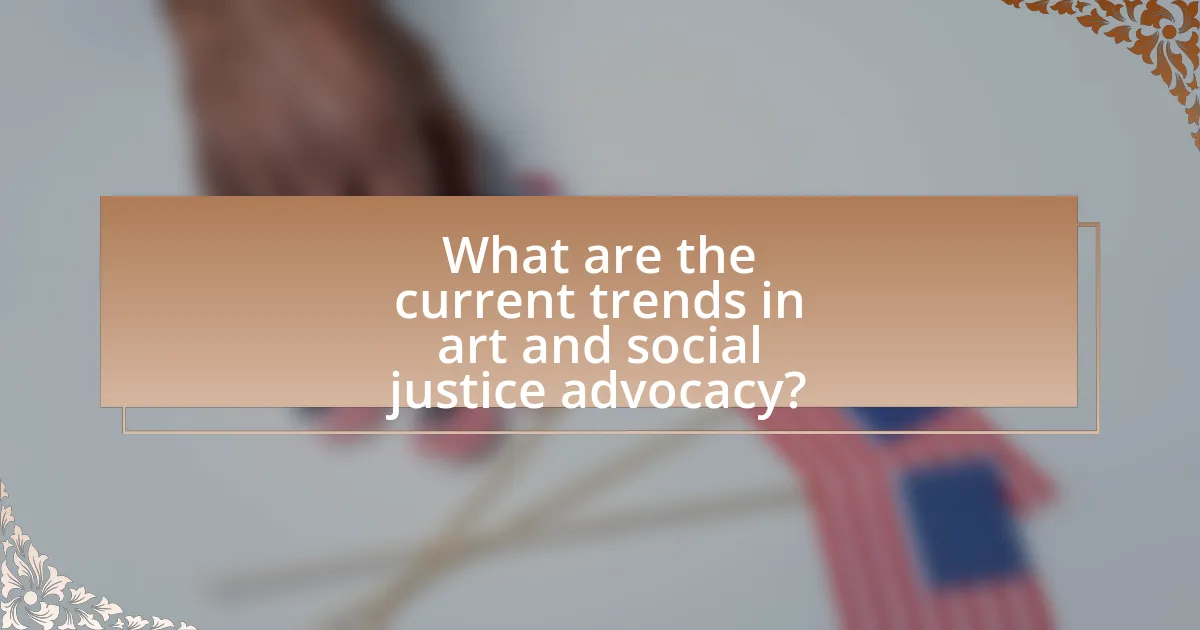
What are the current trends in art and social justice advocacy?
Current trends in art and social justice advocacy include the use of digital platforms for activism, community-based art projects, and the incorporation of diverse voices in artistic expressions. Digital platforms, such as social media, enable artists to reach wider audiences and mobilize support for social justice causes, exemplified by movements like Black Lives Matter, which utilize visual art to convey powerful messages. Community-based art projects foster collaboration and dialogue among marginalized groups, promoting healing and empowerment through collective creativity. Additionally, there is a growing emphasis on intersectionality in art, where artists from various backgrounds address overlapping social issues, thereby enriching the discourse around social justice. These trends reflect a shift towards inclusivity and engagement in the arts, aiming to inspire change and raise awareness on critical societal issues.
How are contemporary artists addressing social justice issues today?
Contemporary artists are addressing social justice issues today by creating works that engage with themes of inequality, identity, and systemic oppression. For instance, artists like Ai Weiwei use their platforms to highlight human rights abuses, while others, such as Theaster Gates, focus on community revitalization and the impact of urban development on marginalized populations. These artists often employ multimedia installations, public art, and performance to provoke dialogue and raise awareness about pressing social issues. Research indicates that art can effectively mobilize communities and influence public opinion, as seen in the rise of art collectives that advocate for racial justice and environmental sustainability.
What mediums are emerging as popular tools for advocacy in the arts?
Digital media, including social media platforms, video content, and interactive websites, are emerging as popular tools for advocacy in the arts. These mediums allow artists and activists to reach wider audiences, engage communities, and facilitate dialogue around social justice issues. For instance, campaigns on platforms like Instagram and TikTok have successfully mobilized support for various causes, demonstrating the effectiveness of digital storytelling in advocacy. Additionally, virtual reality and augmented reality experiences are being utilized to create immersive narratives that evoke empathy and raise awareness about social issues, further solidifying their role in contemporary advocacy efforts.
How is technology influencing the intersection of art and social justice?
Technology is significantly influencing the intersection of art and social justice by providing new platforms for expression and amplifying marginalized voices. Digital tools such as social media, virtual reality, and online galleries enable artists to reach wider audiences, facilitating the dissemination of social justice messages. For instance, the #BlackLivesMatter movement utilized social media to share powerful visual art and narratives, raising awareness and mobilizing support for racial equality. Additionally, technology allows for innovative art forms, such as interactive installations and digital storytelling, which engage communities in discussions about social issues. This integration of technology not only enhances visibility for social justice causes but also fosters collaboration among artists, activists, and audiences, creating a dynamic space for advocacy and change.
What challenges do artists face in advocating for social justice?
Artists face significant challenges in advocating for social justice, primarily due to censorship, funding limitations, and societal backlash. Censorship can restrict artistic expression, as governments or institutions may suppress works that challenge the status quo or provoke controversy. Funding limitations often hinder artists’ ability to create and disseminate their work, as many rely on grants or sponsorships that may not support politically charged themes. Societal backlash can manifest as public criticism or even threats, discouraging artists from engaging in social justice issues. For instance, a study by the National Endowment for the Arts found that artists who address social issues often face increased scrutiny and risk of alienation from certain audiences.
How do funding and resources impact artistic advocacy efforts?
Funding and resources significantly enhance artistic advocacy efforts by providing the necessary financial support and materials for artists to create impactful work. Adequate funding allows artists to develop projects that address social justice issues, reach wider audiences, and collaborate with communities. For instance, a study by the National Endowment for the Arts found that organizations with stable funding are more likely to engage in advocacy initiatives that promote social change. Additionally, resources such as access to venues, technology, and professional networks enable artists to amplify their messages and foster community engagement, ultimately leading to more effective advocacy outcomes.
What risks do artists encounter when addressing controversial social issues?
Artists encounter significant risks when addressing controversial social issues, including censorship, backlash, and potential harm to their careers. Censorship can manifest through government restrictions or institutional pushback, limiting the artist’s ability to express their views. Backlash may arise from audiences or communities who disagree with the artist’s stance, leading to public criticism or social ostracism. Additionally, artists may face career repercussions, such as loss of funding, exhibition opportunities, or collaborations, as seen in cases where institutions withdraw support for artists whose work challenges prevailing norms. These risks highlight the precarious balance artists must navigate when engaging with sensitive topics in their work.
What practical steps can artists take to enhance their impact in social justice advocacy?
Artists can enhance their impact in social justice advocacy by actively engaging with their communities through collaborative projects, utilizing their platforms to raise awareness, and creating art that reflects social issues. Collaborative projects, such as community murals or workshops, foster dialogue and empower marginalized voices, as evidenced by initiatives like the “Art for Justice Fund,” which supports artists addressing criminal justice reform. Additionally, artists can leverage social media to amplify their messages, reaching wider audiences; for instance, campaigns like #BlackLivesMatter have effectively used art to communicate urgent social issues. Creating art that directly addresses social injustices not only raises awareness but also inspires action, as seen in the works of artists like Ai Weiwei, whose installations challenge governmental policies.
How can collaboration with communities strengthen artistic advocacy?
Collaboration with communities strengthens artistic advocacy by fostering authentic connections that amplify marginalized voices. When artists engage with local communities, they gain insights into their unique experiences and challenges, which can inform and enrich their artistic expressions. For instance, community-based art projects, such as murals or performances, often reflect the collective narratives and struggles of the community, making the art more relevant and impactful. Research shows that participatory art initiatives can lead to increased civic engagement and social cohesion, as evidenced by the “Art for Social Change” project, which demonstrated that community involvement in art creation enhances both the quality of the art and its ability to drive social change.
What role does social media play in promoting art for social justice?
Social media serves as a crucial platform for promoting art that advocates for social justice by amplifying marginalized voices and facilitating widespread engagement. Through platforms like Instagram, Twitter, and Facebook, artists can share their work with a global audience, raising awareness about social issues such as racial inequality, gender discrimination, and environmental justice. For instance, the #BlackLivesMatter movement utilized social media to disseminate powerful visual art that highlighted systemic racism, leading to increased public discourse and activism. Additionally, social media allows for real-time interaction and collaboration among artists, activists, and communities, fostering a collective response to social injustices. This dynamic environment not only democratizes access to art but also encourages community-driven initiatives that can lead to tangible social change.
